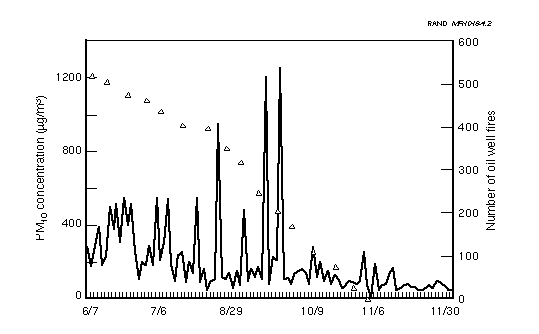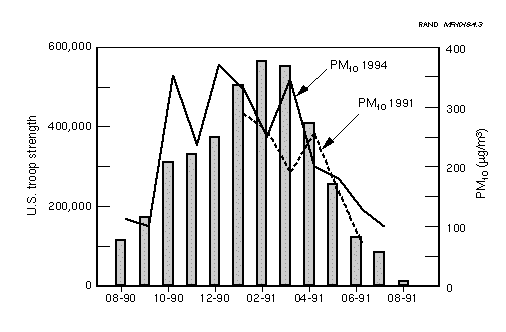
Figure 4.1--Mean Monthly Concentrations of PM10 in Camp Thunderock, Doha, Kuwait, in 1991 and in Kuwait City in 1994
The health surveys conducted during the oil fires indicate increased symptoms and an association between prevalence of complaints and proximity to the oil fires. As yet, there are no data to support those symptoms being indicators of disease or that the symptoms were associated with proximity to the oil fires.
Particulate matter, however, was found to be extremely high at all monitoring sites compared with values in the U.S. The Gulf region is part of the Arabian desert, characterized by high concentrations of very fine sand dust as well as strong winds--particularly during the season of the Shammal winds (from March to September). Because troops are still stationed in the Gulf region, CHPPM continues to monitor ambient levels of contaminants, thus recording environmental concentrations for the region. These data allow for separating exposures due to emissions from the oil well fires from environmental exposures ubiquitous to the region.
Figure 4.1 illustrates the mean monthly PM10 concentrations (black bars) from limited measurements during 1994 in Kuwait City (Kirkpatrick, 1997). For comparison, Figure 4.1 also includes the monthly PM10 concentrations measured during the Gulf War in Camp Thunderock by the (then) USAEHA (USAEHA Interim report). The black bars clearly show the high-PM10 mean concentrations, as well as the arrival of the Shammal winds in March and their gradual disappearance during September-October. The gray bars show that, even in June 1991, when 500 oil wells were still burning, the mean monthly PM10 concentrations were not dramatically higher than is common for that time of the year, as they were originally predicted. However, because these data represent monthly means from limited one-year measurements, they can only be considered as indicators of trends.

Figure 4.1--Mean Monthly Concentrations of PM10 in Camp Thunderock, Doha, Kuwait, in 1991 and in Kuwait City in 1994
Daily PM10 concentrations varied dramatically, from less than 100 �g/m3 on one day to 1200 �g/m3 the next, as illustrated in Figure 4.2. The chart also shows the rate at which the oil fires were extinguished (triangles).

Figure 4.2--Daily PM10 Concentration in Camp Thunderock, Doha, Kuwait, from June to December 1991
A large concentration of dust in itself may be inconsequential as a health risk unless the dust contains a significant amount of PM10 particles. Inhaled particles of 2.5-10 �m deposit in the ciliated portion of the lung and are removed by the "mucociliary escalator" in about 24 hours. Particles larger than 10 �m are either filtered in the nose or land in the mouth and throat and do not reach the lung. Particles smaller than 2.5 �m penetrate deeply into the lungs and can remain there for a long time.
The size distribution of the particles in the above-discussed ambient air samples were also measured. Figure 2.5 depicts the particle size distribution in air samples from Kuwait and Saudi Arabia. The analysis from these few samples indicates that there was a significant mass of particles in the size range that may have an effect on the respiratory system, particularly to those in sensitive or at-risk subgroups of the population. It is interesting to note that, within the military personnel stationed in Kuwait in 1994, during Operation Vigilant Warrior, there were more medical entries for respiratory codes than for orthopedic codes (USACHPPM, 1994).
Mostly because of its location, the Gulf War and its concomitant exposures could explain some of the respiratory complaints and diseases reported by its veterans. In particular, the exposures may explain the difference in asthma and bronchitis levels found in the Iowa Study between military personnel who went to the Gulf and those who did not. Figure 4.3 shows the time distribution of U.S. troops from August 1990 to August 1991, when most troops were re-deployed from the Gulf, together with the monthly mean PM10 measured in 1991 and 1994. This graph shows that, when the PM10 concentrations started to rise in March 1991, about 500,000 U.S. troops were in the region and could have been exposed to PM10 levels higher than the NAAQS for several months.

Figure 4.3--U.S. Troop Strength and PM10 Concentrations Versus Time
These results, together with the data in Figure 4.1, suggest that most of the exposures due to inhaled contaminants that had a potential for health risk were less likely to have come from the burning oil wells than to have come from the amount of very fine sand in the air.
A significant number of Gulf War veterans were smokers. Smokers, even young smokers, may react differently than nonsmokers to inhaled pollutants regardless of exposure levels. Also, a percentage of the veterans may have had some underlying predisposition to pulmonary disease that might have been triggered by exposure to high levels of PM10. These high levels of PM10 may explain the preliminary findings of the Iowa Study regarding respiratory symptoms as well those reported in the CCEP.
Further research is needed on the health effects of exposure to multiple pollutants. Many questions need to be answered; for example, do the effects of inhaled particulate matter and other toxicants exceed those attributable to any one agent acting individually?
| First Page | Prev Page | Next Page | Back to Text |